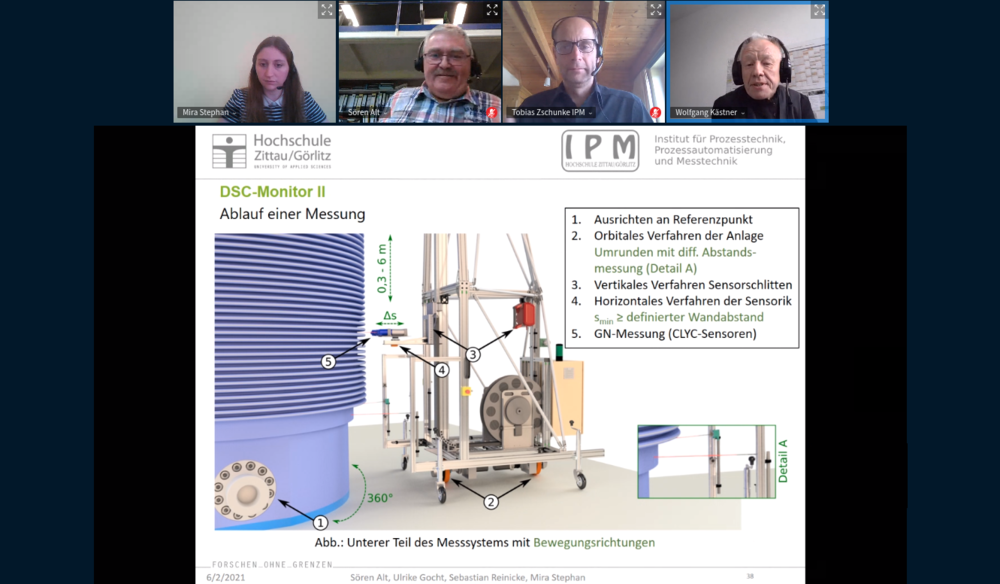An overview of current nuclear safety research projects was given at an IPM institute colloquium held online together with the Faculty of Mechanical Engineering.

Safety research is a field of engineering science in which mechanical and plant engineering and process engineering have always combined with computer science and artificial intelligence. In the Institute of Process Engineering, Process Automation and Metrology (IPM), the HSZG has been building up and pooling expertise in this field for years. The particular strength of the women and men working here as research staff lies in the field of nuclear safety research. An overview of current projects was given at an institute colloquium held online together with the Faculty of Mechanical Engineering on June 2, 2021:
The project "Fast calculation of real material properties in the AC² program system according to the latest IAPWS standards (SBRS-AC2)" pursued the development of a material value library for water and water vapour and its implementation in the simulation code ATHLET of the Gesellschaft für Anlagen- und Reaktorsicherheit (GRS) gGmbH. Using spline-based table look-up methods, an accurate and at the same time very fast calculation of material values was realized.
Funded by: BMWi
More information on the project at https://fis.hszg.de/787.html
"Generic thermo-hydraulic and physico-chemical analyses for the implementation of an ATHLET module for the simulation of thermo-hydraulic consequences of zinc borate deposits in the PWR core (AZora)" is a joint project of the institutions HSZG, TU Dresden (TUD), Helmholtz-Zentrum Dresden-Rossendorf (HZDR) and GRS. The main contents include experimental work and analyses by the HSZG on a semi-industrial scale, which will result in the implementation of an ATHLET module for the simulation of thermal-hydraulic consequences of zinc borate deposits in the PWR core.
Funded by: BMWi
More information on the project at https://fis.hszg.de/936.html
Mira Stephan and Sebastian Reinicke reported on the project "Development and testing of methods for the non-invasive analysis of the inventory condition of transport and storage casks during extended interim storage (DCS-Monitor II)", in which in-depth analyses and experimental evaluations of radiometric detection methods for (largely geometric) changes in the inventory of CASTOR casks are carried out on the basis of gamma , neutron and muon fields. As a result, a validated and practically applicable monitoring procedure will be developed for these casks. The HSZG is cooperating with the TU Dresden and the Helmholtz-Zentrum Dresden-Rossendorf.
Funding body: BMWi / GRS
More information here: https://fis.hszg.de/1054.html
The project, which started on 1. The project "Radiological characterization of nuclear facilities and buildings using collimation-free, directionally resolved in-situ gamma spectrometry" (Quantitative Gamma-Ray Imaging - without collimatorS - QGRIS), which was launched on 1 June this year as part of the BMBF's FORKA - Research for the Decommissioning of Nuclear Facilities funding measure, the HSZG is supporting the prototype development of a collimation-free gamma camera planned by Hellma Materials GmbH from Jena in the sub-project "Experimental investigations and simulation". The HSZG is cooperating with Hellma Materials, the Friedrich-Alexander University Erlangen-Nuremberg, the VKTA - Strahlenschutz, Analytik und Entsorgung Rossendorf e. V. and is participating in the development of positioning systems for radioactive sources and absorber walls as well as with model calculations of the simulation software FLUKA.
Funded by: BMBF
Public interest in nuclear safety research is constantly increasing. A recent Allensbach survey has just revealed that only just over half of Germans still approve of the nuclear phase-out. In the meantime, the working methods of the ethics commissions set up by the German government to phase out nuclear energy have also come under fire. The background to all this is that nuclear energy is perceived by many who are concerned with climate protection as a green form of energy with great potential for the future.